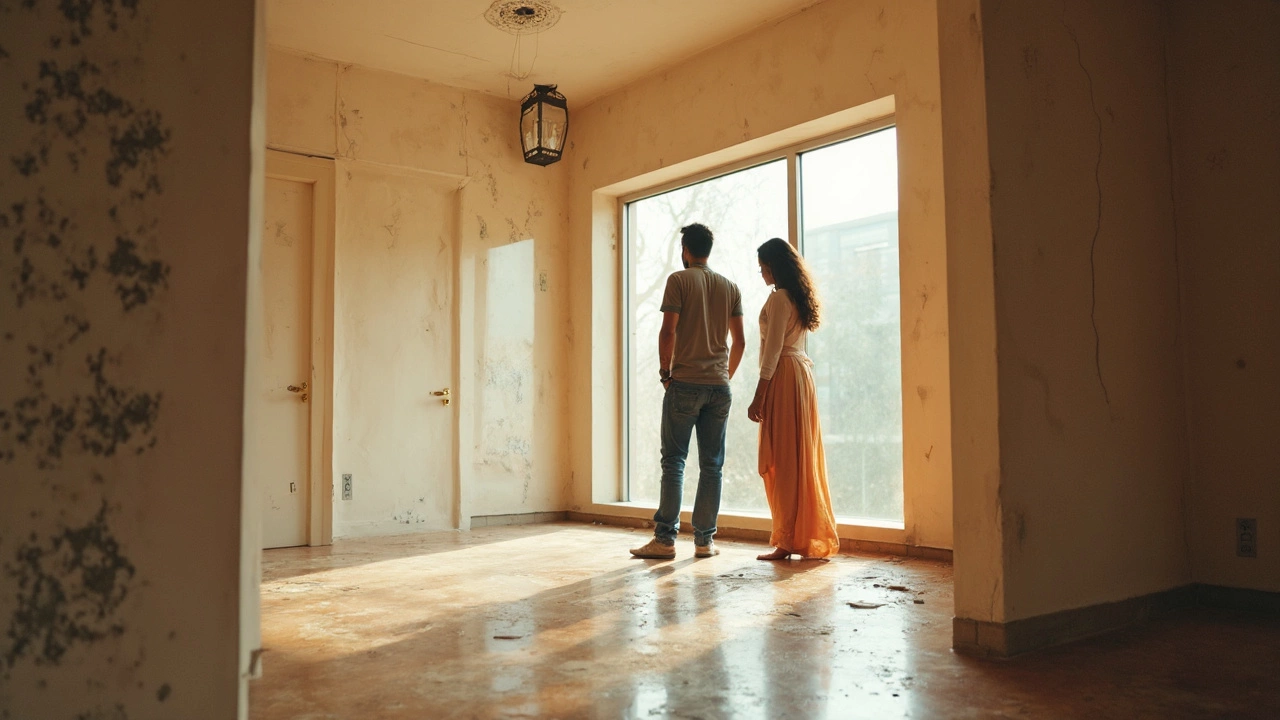Buying a new build home can be both exciting and terrifying at the same time. You assume everything will be perfect, after all, you’re the first owner. But what if things aren’t quite right? That’s where the word 'defects' comes in, and it’s something you definitely don’t want to ignore.
So, what constitutes a defect in a new build? Simply put, it’s any part of the construction that doesn’t meet the required standards. This could be a crack in the wall, a leaky pipe, or even a foundation issue. It might sound scary, but understanding these defects and knowing how to handle them can make all the difference.
One surprising fact is that about 55% of new homeowners report defects within the first year. Knowing what to look for early on can save you loads of time and stress. A top tip? Keep an eye out for any odd noises or smells—sometimes, your senses can pick up on issues before they become visible.
- Understanding Construction Defects
- Common Defects in New Builds
- Spotting Red Flags Early
- Your Rights and Responsibilities
- Handling Defect Disputes
Understanding Construction Defects
Diving into the nitty-gritty of construction defects can feel overwhelming, but it’s crucial to understand the basics. A defect in a new build isn't just sloppy work; it's any element failing to meet the expected standard of workmanship or materials. Why does this matter? Because it could affect everything from safety to insurance claims.
Types of Construction Defects
Construction defects typically fall under three main categories: design defects, material defects, and workmanship defects. Design defects arise when flaws in the architectural design lead to performance issues. If it’s not modeled right, it won’t be built right.
Material defects happen when subpar materials are used, even if the installation is spot-on. Finally, workmanship defects occur when the quality of the installation is poor. Imagine improper roofing installs that lead to leaks.
“Identifying defects early on can prevent costly future repairs and preserve the value of your property,” says Jane Doe, an expert from the National Association of Home Builders.
Common Examples
- New builds often encounter foundational cracks. These are more than just cosmetic issues; they can impact structural integrity.
- Electrical and plumbing problems are also frequent culprits. Whether it's wiring that isn’t up to code or a leaky pipe hidden behind walls, these can lead to bigger headaches down the line.
- Improper insulation affects energy efficiency, leading to higher utility bills—something no homeowner enjoys.
Now, let's not forget stats. Did you know the average cost to fix a home defect runs around $80 per square foot? That’s something to keep in mind as you spot issues early on.
Common Defects in New Builds
Even in the shiniest new homes, things can go awry. You might expect a new build to be flawless, but defects do crop up more often than you’d think. Let’s break down the usual suspects.
Structural Issues
No one wants to discover foundation problems in their brand new home. Unfortunately, it happens. Construction defects like uneven floors and significant wall cracks can indicate foundation trouble. Pay close attention to any cracks wider than a quarter of an inch.
Plumbing Problems
Leaky faucets or slow drains aren’t just annoyances; they’re red flags. In many new builds, plumbing issues arise from improper installation or subpar materials. Watch for persistent moisture spots which might mean hidden leaks.
Electrical Faults
Electrical systems need to be spot-on for safety. Flickering lights or frequent circuit breaker trips shouldn’t be ignored. Always ensure your wiring is up to code and safe to use.
Poor Finishing
This is more common than you might like. It includes things like uneven paint jobs, wonky tiles, or misaligned fixtures. While these might seem minor, fixing them can be frustrating and time-consuming.
Insulation and HVAC
Improper insulation or faulty HVAC systems are sneaky defects that hike up energy bills. You could end up with a home that’s too hot in summer and too cold in winter, which isn't ideal. Make sure vents aren’t clogged and your systems are working efficiently.
Data on Defects
Want some numbers? Here’s a quick look:
| Type of Defect | Frequency (%) |
|---|---|
| Structural Issues | 20 |
| Plumbing Problems | 15 |
| Electrical Faults | 10 |
| Poor Finishing | 35 |
| Insulation and HVAC | 20 |
As shown, poor finishing is a leader in complaints. Always double-check even the smallest details before moving in. You’ll save yourself from future hassles.

Spotting Red Flags Early
Nobody wants to discover issues with their brand new home after moving in. To avoid costly surprises, it’s smart to know what to look for before you're knee-deep in unpacked boxes. Even small construction defects can be early warnings of bigger issues down the road, so spotting them early is key.
Eyes Wide Open
When you walk through the home, take the time to check every nook and cranny. Look at the walls and ceilings for cracks or damp spots. Does the paint seem patchy or uneven? These can indicate underlying problems. Turn on the faucets and listen—do you hear any rattling pipes? Check for water pressure inconsistencies, too.
Floor to Ceiling Check
Floors should be level and squeak-free. Tiles? Make sure they aren’t cracked or uneven. Also, keep an eye on door and window frames. Are they aligned properly? If they don’t close without a hitch, it could be a sign of a bigger property issue.
The Sniff Test
Sounds odd, but a quick smell test can go a long way. Musty or chemical smells might signal mold or poor ventilation. While sniffing around, pay attention to any signs of pests, like droppings or gnawed wood.
Document Everything
Bring your phone and snap photos of anything that looks off. Take a notebook, jotting down any concerns you have along the way. Pictures help a lot when you're discussing home defects with your builder later.
The Right Tools
If you're not sure what to look for, consider hiring a professional inspector. They can spot even the sneakiest of defects. Plus, they have a trained eye for catching things most of us might miss.
Being vigilant can end up saving you more than just money—it saves you stress. And trust me, a bit of homework now will keep your new new build as hassle-free as possible.
Your Rights and Responsibilities
When it comes to addressing defects in your new build, knowing your rights and responsibilities is half the battle. You're not just buying a structure; you're entering a legal territory where certain protections have your back.
Know Your Warranty
First off, dive into the warranty details. Most builders offer a warranty that covers specific construction defects for a set period. This could range from one year for cosmetic issues to up to ten years for major structural problems. Make sure you understand what’s covered, how long it lasts, and the process to claim it.
Document Everything
Keep a detailed record of all communication with your builder and any issues you notice. Take photos, note dates and times, and save all emails and messages. This documentation can be crucial if you need to prove a point later on.
Your Responsibility
As a homeowner, your responsibility is to maintain the property. Follow the builder’s upkeep guidelines to avoid voiding your warranty. For example, neglecting regular maintenance like clearing gutters or fixing small leaks might shift the blame onto you if these issues lead to bigger problems.
Getting Professional Help
Sometimes, it pays to bring in an expert. Hiring a licensed inspector or a construction lawyer can help you make your case if things get sticky with the builder.
Here’s a quick look at common warranty periods:
| Type of Defect | Common Warranty Length |
|---|---|
| Cosmetic Issues (paint, trim) | 1 year |
| Mechanical (HVAC systems) | 2-3 years |
| Major Structural Defects | Up to 10 years |
Remember, knowing your rights and playing your part ensures that your brand new home remains the good investment it should be.

Handling Defect Disputes
So, you've found a defect in your new build and now you're wondering what to do. First, don't panic. There's a process to follow, and knowing it can help you get things sorted effectively.
Document Everything
The key here is documentation. Make sure you take photos and keep notes about any issues you find. This information will come in handy if things escalate. Plus, having a record gives you something to show the builders or any legal parties involved.
Contact the Builder First
Your first step should always be reaching out to the builder or developer. They should have a warranty or guarantee in place for these kinds of situations. Provide them with all the documented evidence you have and give them a reasonable amount of time to respond.
Know Your Rights
Understanding your rights is crucial. The Consumer Code for Home Builders outlines what new home buyers can expect. If your builder isn't following this, you might have grounds to take further action. You might even be eligible for compensation depending on the defect's severity.
Escalation and Legal Steps
If the builder isn't playing ball, you might need to escalate the issue. This is where professional help comes in. Getting advice from a surveyor or legal expert can shed light on your options.
- Seek legal advice from a property solicitor.
- Contact a home warranty provider if applicable.
- Consider mediation services to reach a resolution.
Remember, knowing your facts and having proper documentation can significantly strengthen your position. If going the legal route, it's often less costly than many think, especially when you might recoup costs through compensation.
Settlements and Outcomes
Most disputes get resolved through direct contact with the builder. However, in rare cases, it might lead to arbitration or court. Here’s a quick look at how these outcomes might vary:
| Resolution Method | Typical Outcome |
|---|---|
| Direct Builder Contact | Minor repairs or fixes |
| Mediation | Settlement agreement |
| Legal Action | Possible compensation |
Overall, don't hesitate to get the defects sorted. It’s your home and you deserve peace of mind.

Written by Fletcher Abernathy
View all posts by: Fletcher Abernathy